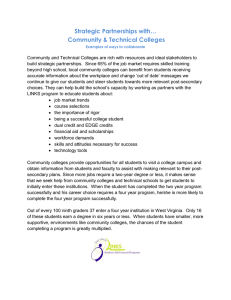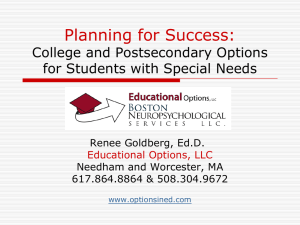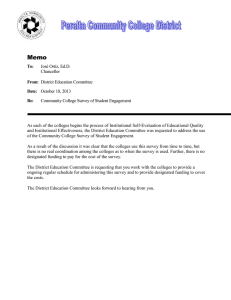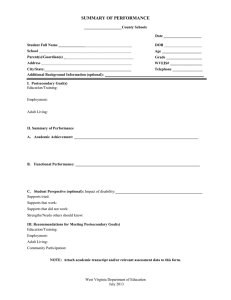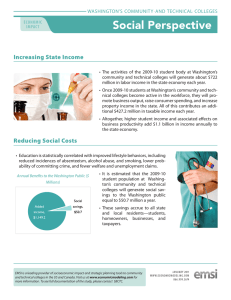AACC Update - National Perspective on Community College
advertisement
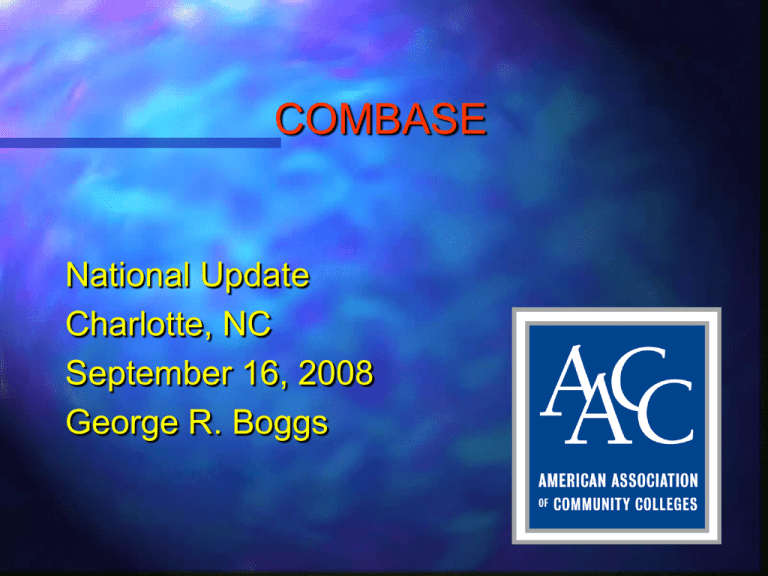
COMBASE National Update Charlotte, NC September 16, 2008 George R. Boggs Why Community Colleges are Important Community Colleges in the US Community College Values Access >>> Success Community Responsiveness Clear Focus on Student Learning Resourcefulness Entrepreneurial Spirit Creativeness Innovativeness Changing Face of America The Degree Gap Percent with BA or higher (2000) 28% of whites 17% of African Americans 11% of Hispanics Relationship of Income to College Access Rate Family Income 88.8% > $74,584 68.2% $25,064-$47,405 53.3% < $25,064 Societal Change High Skilled & Unskilled Jobs as a % of the Workforce, 2000 to 2012 2000 25% 20% 2002 20.7% 18.4% 19.2% 2012 13.0% 15% 11.8% 10.9% 10% 5% 0% Professional & Related Occupations Source: Bureau of Labor Statistics Production, installation, maintenance & Repair Occupations Certificates and Degrees change lives Higher levels of education lead to higher earnings for all racial and ethnic groups and for both men and women. People with associate degrees generally earn 20 to 30 percent more than people with only high school diplomas. Civilian Labor Force by Educational Attainment 1970 to 2004 45.0% High School Graduate 40.0% 35.0% 30.0% Bachelor's Degree or More 25.0% 1-3 Years College 20.0% 15.0% 10.0% Less Than 4 Years High School 5.0% 2004 2003 2002 2001 2000 1999 1998 1997 1996 1995 1994 1993 1992 1991 1990 1989 1988 1987 1986 1985 1984 1983 1982 1981 1980 Source: Bureau of Labor Statistics 1979 1978 1977 1976 1975 1974 1973 1972 1971 1970 0.0% Shared Prosperity? Education Required Projected Growth in Supply and Demand of Workers With Some Postsecondary Education, 1998 to 2028 Jobs requiring some postsecondary experience Workers with some postsecondary experience 150,000 140,000 Thousands 130,000 120,000 110,000 100,000 90,000 80,000 70,000 60,000 1998 2008 2018 2028 Source: Bureau of Labor Statistics, U.S. Census Bureau and National Alliance of Business America’s Future at Stake 75% of new jobs require some postsecondary education. Only 35% of Americans (25-34) have 2 or more years post-secondary education. – -Source: 2000 data National Information Center for Higher Ed. Job growth estimates for the 2010 workforce Based on 2005 U.S Census data + U.S. Department of Education, Office of Adult and Vocational Education, "The Economic Imperative for Improving Education," in The High School Leadership Summit, Issue Papers (Washington D.C., 2003), Figure 2. Today’s Workforce: Data for 25+ year olds Source: 2005 U.S Census data Overlapping these profiles shows a significant gap will need to be closed! “Work gets done where it can be done most efficiently and effectively.” (Friedman, 2005) More Emphasis on STEM Competitiveness NAS Gathering Storm report Friedman’s flat world NSB commission ACGs and SMART Grants – WDI – AACC/NSF ATE PI conference More Enrollment Pressure for CCs Rising university tuition costs and increased selectivity will drive more students to CCs Increased need for LLL will drive up enrollments Retiring Baby Boomers will increase enrollments Immigration will remain a political issue for a while DREAM act will still be politically sensitive May cool somewhat if economy continues to be strong Growing recognition for need to retain some international students Accountability Again More focus on success of students—not just access Evidence of student learning will be required by accrediting agencies, states, and federal government Colleges will move toward a culture of evidence and use of data We can help more community college students succeed Achieving the Dream is about being open and forthright about performance — and doing what it takes to improve it. Trend for Increased Student Mobility, but many are Place-Bound Better articulation agreements with universities More university centers on CC campuses More distance learning opportunities More Focus on K-12 Transitions Expectations for HE need to be made clear Transitions need to be improved – League’s CCTI – GEAR-UP – Concurrent enrollment – Middle College HS Growing Importance of Global & Intercultural Education Emerging global society and economy – Friedman’s flat world – Bush National Defense Foreign Language Initiative – AACC work with Dept. of State – AACC Recruitment efforts Trips, Web page, study guide, map Funding Issues will Remain More competition for state resources For-profit institutions will become more aggressive in seeking public funds CCs will become more adept in seeking private resources, earmarks, and grant funds Current Issues Presidential Campaigns Campus safety and security Accreditation challenges Leadership and faculty turnover Environmental Issues Additional Policy Issues – WIA Reauthorization, Tax Issues, etc. American Association of Community Colleges The Voice of America’s Community Colleges

